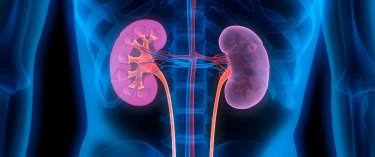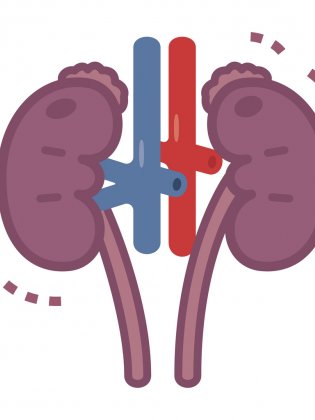
What is kidney cancer?
Definition, symptoms and treatments for kidney cancer
What should I know about the kidneys?
The kidneys are two bean-shaped organs located just below the ribs on either side of the spine. In adults, they are approximately 10 to 12 cm long and 3 cm thick.
They perform several vital bodily functions:
- Eliminate waste products from the body (urea, creatinine, uric acid, drug residues) by filtering nearly 200 liters of blood each day and eliminating approximately 2 liters of fluid through the urine
- Balance the volume of fluids and minerals: they ensure the body is working properly by maintaining the necessary amounts of fluids and minerals
- Produce essential hormones: EPO for the production of red blood cells, and renin, which regulates blood pressure
What are the symptoms of kidney cancer?
In kidney cancer, the kidney cells divide and multiply uncontrollably, gradually accumulating into a mass of abnormal cells and eventually forming a tumor.
Several types of tumor may develop, depending on the type of cell that is dividing uncontrollably. The most common type of kidney tumor is clear cell renal cell carcinoma. Other types include papillary and chromophobe renal cell carcinoma.
An oncocytoma is a particular type of benign mass in the kidney that never metastasizes. Nevertheless, if the oncocytoma becomes too large, radical treatment such as cryoablation or a partial nephrectomy may be proposed.
Kidney cancer is a silent cancer.
In the early stages, it does not cause any symptoms and is often discovered by chance during a CT scan performed for another reason or during a routine medical checkup. At this early stage, the prognosis for a complete recovery following radical treatment (cryoablation or partial nephrectomy) is excellent in most cases.
It is essential to minimize the risk of complications resulting from any treatment and to preserve kidney function. Kidney-conserving treatments that spare the healthy kidney must be prioritized insofar as possible. These include partial nephrectomy, in which the tumor is surgically removed, leaving the healthy part of the kidney intact, or percutaneous cryoablation, in which extreme cold, delivered through a needle under CT scan guidance, destroys the tumor.
When the disease has attained a later stage, symptoms appear. Advanced-stage kidney cancer symptoms include:
- Hematuria: blood in the urine (recurrent but painless)
- Kidney pain: on the side of the body, just below the ribs
- A lump or nodule: palpable in the lumbar region
Symptoms may also include fatigue, weight loss or an unexplained fever.
What are the risk factors for kidney cancer?
There are no clearly defined causes for kidney cancer. The disease has nevertheless been linked to many risk factors. Being exposed to one or more of these factors does not mean a person will necessarily develop kidney cancer, but does increase the risk.
Main risk factors:
- Sex: kidney cancer occurs twice as often in men than in women
- Age: mainly affects people over 50
- Excess weight and obesity: the higher one’s body mass index, the greater the risk
- Smoking: smokers are one-and-a-half times more at risk of developing kidney cancer
- Diabetes and high blood pressure: both are linked to chronic kidney failure
- Hereditary factors: for instance, von Hippel-Lindau disease
- Dialysis treatment for more than three years: renal cysts are more likely to develop in people on dialysis
How is kidney cancer diagnosed at the American Hospital of Paris?
A kidney cancer diagnosis is mainly based on a CT scan (computed tomography scan). If scan results do not allow the tumor to be formally characterized as malignant or benign, an MRI is sometimes also performed.
Imaging exams are essential to diagnosis, as the clinical exam generally reveals nothing abnormal (unless the tumor is large enough to be felt with the hands).
The diagnosis is then confirmed with an anatomic pathology analysis, which consists in analyzing under a microscope a kidney specimen removed through a biopsy procedure. The results are used to determine the stage, the type of cells affected and the tumor’s potential for growth.
What treatment options are available for kidney cancer at the American Hospital of Paris?
Kidney tumors generally resist chemotherapy and radiation therapy. Two options are currently available at the American Hospital of Paris: surgery and cryoablation. The goal is to preserve maximum kidney function.
Surgery: total or partial nephrectomy
Nephrectomy (nephro = kidney and ectomy = removal) consists in the surgical removal of the kidney. Depending on the tumor’s size, this surgery can be:
- Total: the entire kidney is removed
- Partial: only the tumor is removed, the rest of the organ is spared.
A partial nephrectomy is performed whenever possible, as it allows better long-term kidney function preservation. While outcomes are generally good, surgery can lead to complications such as a risk of infection or hemorrhage.
An alternative to surgery: kidney cryoablation
Kidney cancer is often discovered by chance, when the tumors are still small, non-aggressive and asymptomatic. The goal of treatment is to preserve maximum kidney function, a key factor in positive long-term outcomes.
An alternative to kidney cancer surgery has been available for approximately ten years. For tumors less than 4 cm in diameter, kidney cryoablation is possible. The American Cancer Society recommends either cryoablation or partial nephrectomy as the first-line treatment for these small kidney tumors.
Cryoablation is a minimally invasive technique performed on an outpatient basis under local anesthesia in an interventional radiology room. Unlike surgery, no incisions are made. Instead, one or several needles are inserted into the tumor. The tip of the needle is then brought to an extremely cold temperature (-180° C/ -292° F), creating an ice ball that surrounds and destroys the tumor. The entire procedure is guided by a CT scan.
Cryoablation makes it possible to fully preserve kidney function; there is no risk of developing problems tied to kidney failure. In terms of curing the cancer, the results are as good as surgery.
In addition, this alternative kidney cancer treatment facilitates the postoperative phase. There are fewer complications, less blood loss and need for transfusion, and a shorter hospital stay than with partial nephrectomy. This scarless procedure ensures a rapid, quasi-painless recovery enabling patients to resume their normal activities within 48 hours.
KIDNEY CANCER IN FRANCE : KEY FIGURES
15 323
Number of new cases of kidney cancer in 2018, of which 67 percent in men.
5589
Estimated number of annual deaths, of which 68 percent in men.

